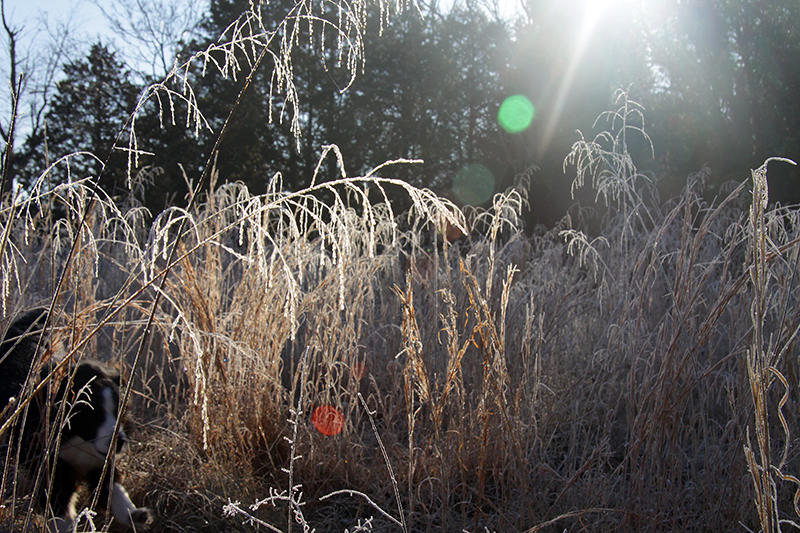December 26th, 2013 §
Last week I took the train up to Connecticut to visit a friend and caught this view approaching Manhattan. I like how this photo plays with scale, the skyscrapers of lower Manhattan dwarfed by the towers in the forefront, and all of it seemingly floating on a frozen marsh. Nature below, manmade above. You can see the Freedom Tower catching the sunset. I think the design is simple but very elegant, and I really like how the light plays on its different sides.

From Connecticut, we took the train into Manhattan for a day and our first destination was the High Line, a public park and garden with planting design done by my favorite garden designer, the Dutchman Piet Oudolf. The High Line used to be an abandoned, overgrown elevated railway until the Friends of the High Line got together in 1999 and garnered enough public support for the park that in 2004 New York City granted $50 million for the project.
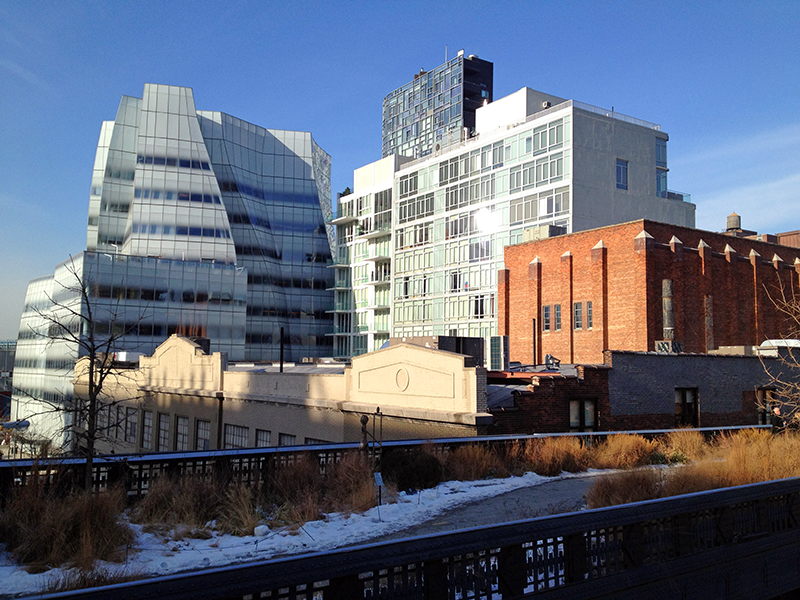
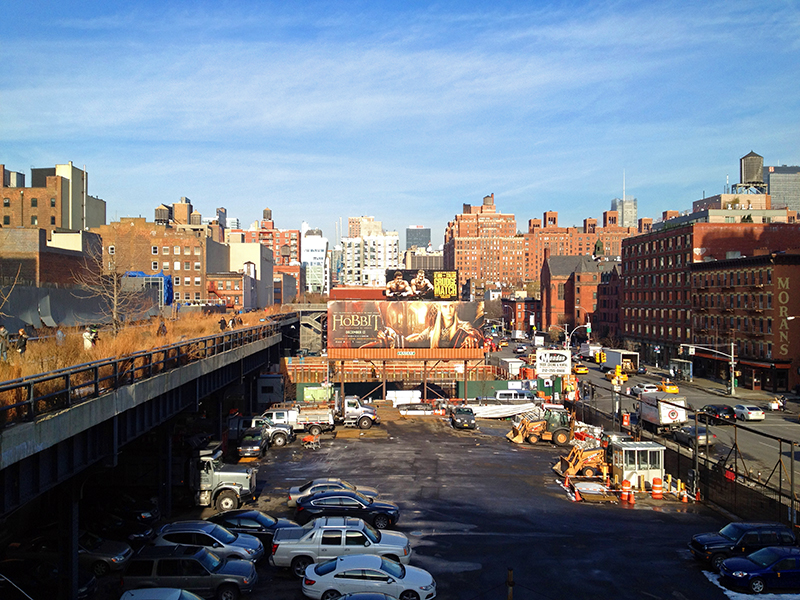
The park has been completed in sections since then, and it’s achieved worldwide recognition for its success at transforming urban blight into public greenspace, and revitalizing a formerly decrepit area of the city. Chicago, Philadelphia and St. Louis are studying the High Line as a potential model for their cities.
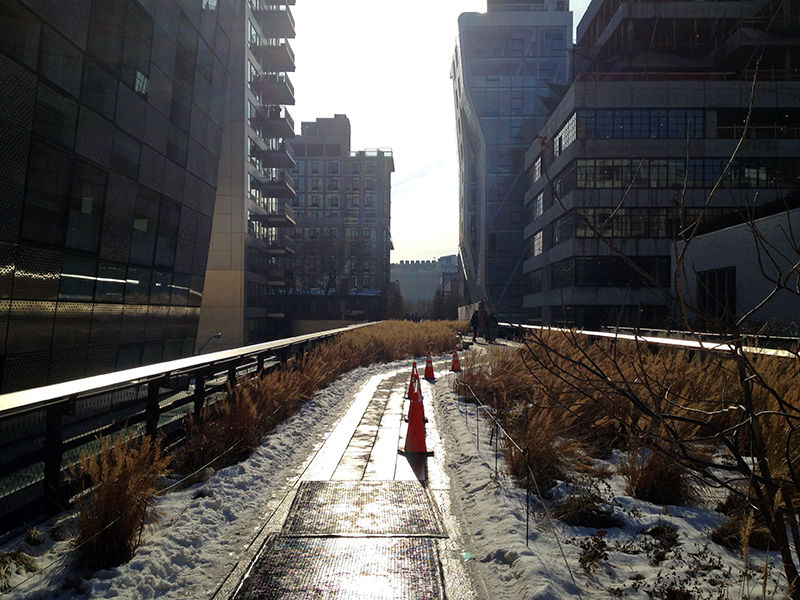
All this to say that although I’ve followed this project for years, I hadn’t actually gotten the chance to visit until last week. And I was so impressed. The hardscape materials—steel, glass and concrete—were combined with enough weathered wood to warm up the garden without losing touch with its urban environment. I loved the little alcoves that jutted off the main path. They formed garden rooms that would give a gathered group of friends a sense of intimacy while still allowing them to be part of the action.
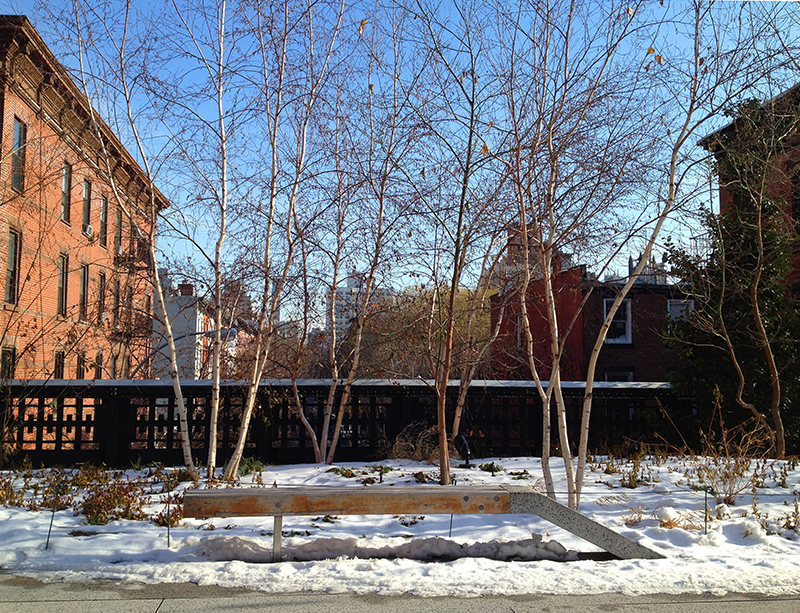
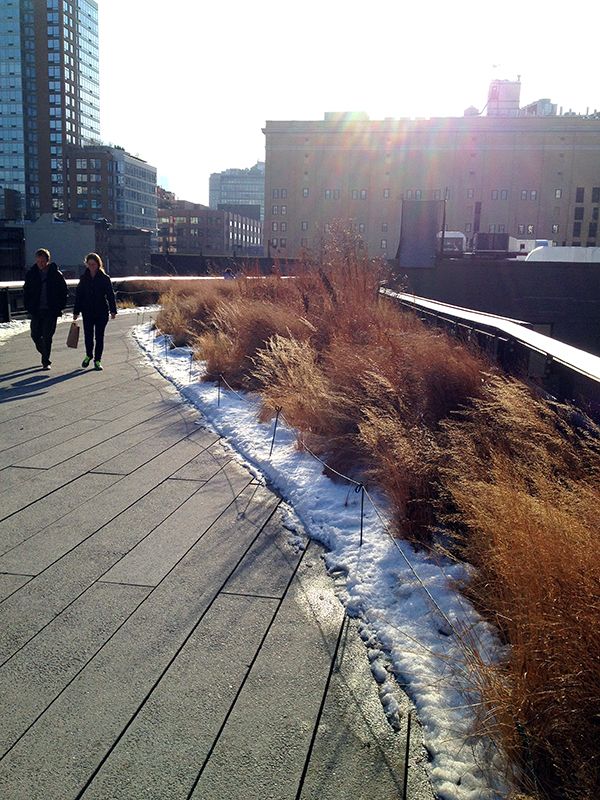
And of course, the plantings were awesome. I know enough about Oudolf’s work to expect a lot of grasses and dried seedheads this time of year, and the High Line didn’t disappoint. Oudolf designs for four-season interest, and I suspect that the dried plant material and stark, berried bushes we saw in winter might be even more interesting than the abundant but overplayed flowers of summer. A blanket of snow threw all the plants into beautiful relief and was an extra bonus.
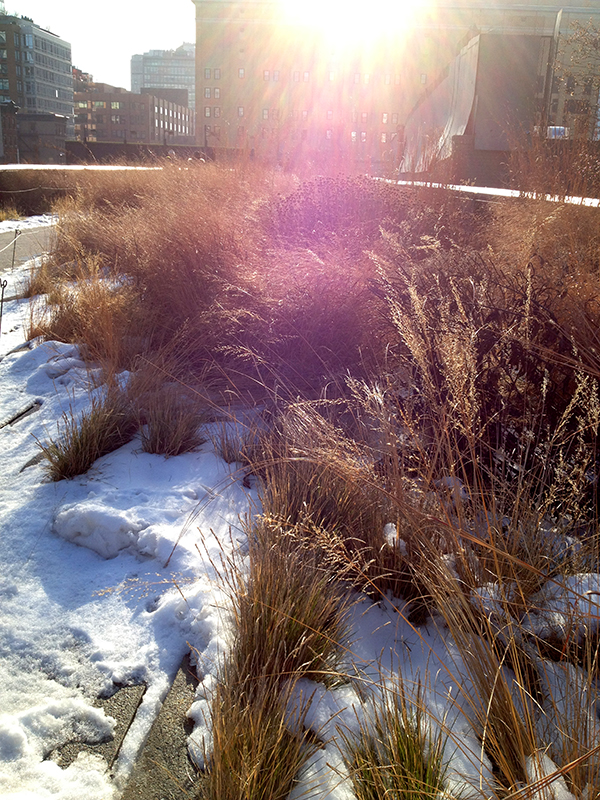
I know “naturalistic,” “new perennial,” and “meadow” planting are so trendy in garden design right now, and I also know just how much work and knowledge it takes to put together a garden design that replicates a natural meadow. But I was really struck, as I walked the High Line, by how it looked like one could have just transplanted a section of my front yard right into Manhattan. If that was Oudolf’s intention, and I believe it was, no doubt he succeeded. And maybe I succeeded too, by setting up my home in a natural, beautiful meadow without having to plant it first! Art imitates life, life is—if we keep our eyes open—art.
Bonafide Farm, February 2013
November 25th, 2013 §
As we head into the last month of 2013, I figured I better record some of the larger projects I undertook this year but didn’t manage to write about. I know they’re no longer newsy, but I find that I frequently refer to my own blog to jog my memory about when I did certain projects, so it’s important to get them up here even if they’re month’s late.
First up, the ironic hydrant installation. Backstory: for the first year I gardened here, I carried 5 gallon buckets of water, one in each hand, to water the vegetable garden. Then I wised up and ran a few hundred feet of garden hose from the spigot on the well house. It lay across the field and driveway all summer, in all its crappy artificial green glory, and made not only an eyesore but a pretty annoying mowing obstacle.
Of course, each of these summers saw record high temperatures, summer droughts, and even some pretty serious storms that killed the power for sometimes up to a full week. I did my best to keep the garden watered, but finally told myself my plants had better grow some deep roots and fend for themselves. I threw on a thick layer of straw mulch and walked away.
Come spring 2013, I decided it was time to get some proper water out to the vegetable garden. So I called a nice guy and we set a date for him to come install a water line and frost-free hydrant. And then it started raining. And didn’t stop all spring. Which was great for my young garden, but we kept having to push back our installation date because it was raining too much to open the deep trench that was required to house the water line. And so, with these flooded conditions it was June 25 until it was dry enough to install the hydrant.
But the crew arrived that morning and within a few hours had opened a deep trench all the way from the wellhouse, where all my plumbing is located, to the garden.
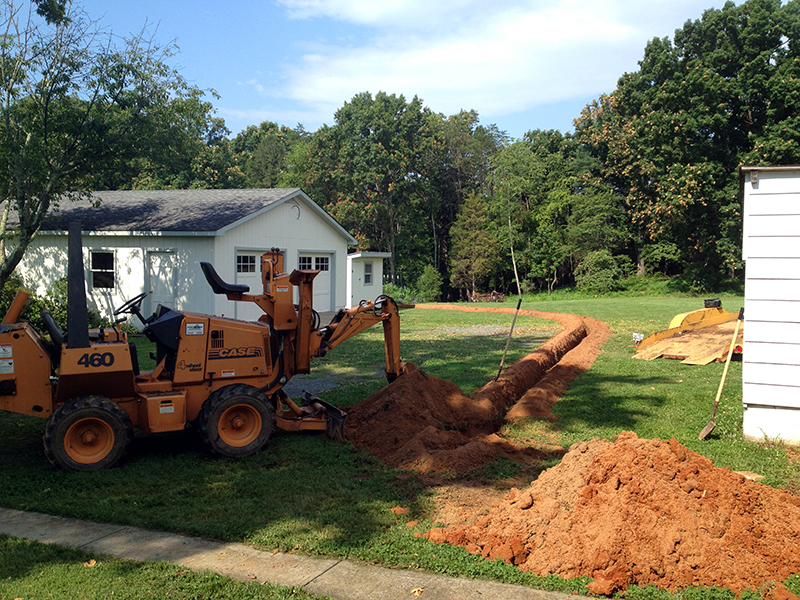
They installed a new water line coming through the foundation of the wellhouse basement and ran pipe in the trench…
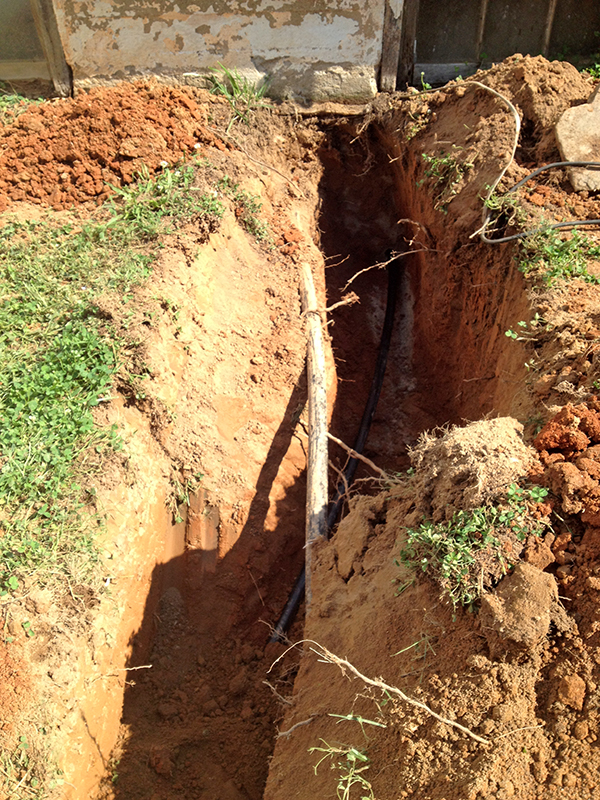
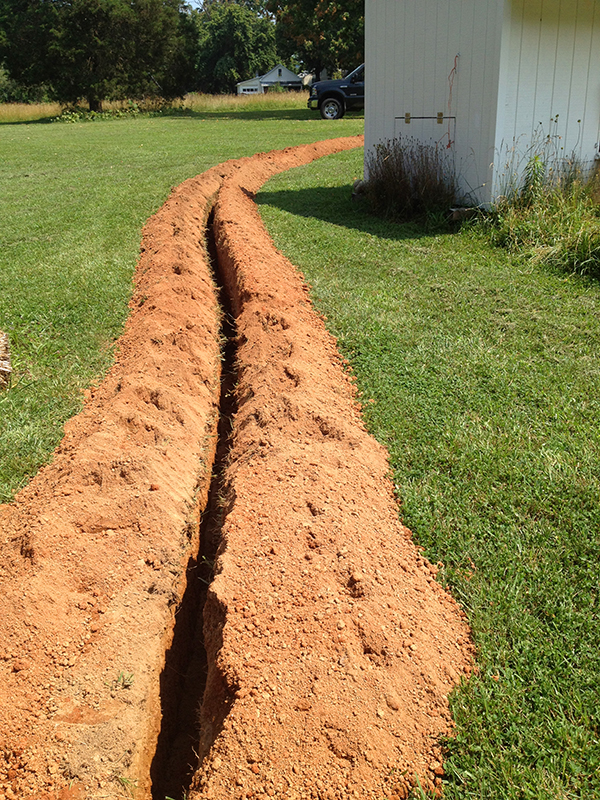
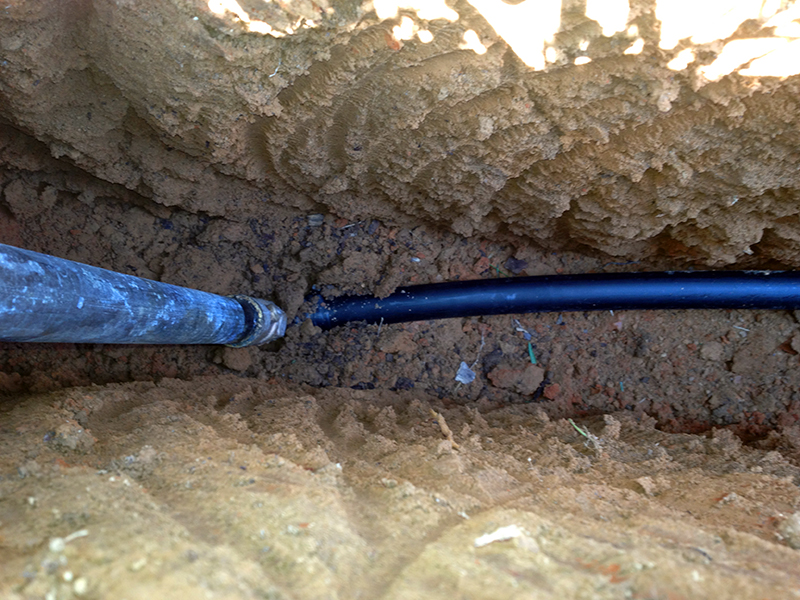
...and out to a new hydrant right next to the vegetable garden. I chose to not put the hydrant within the garden so I could use it to fill the chicken waterers without going in the garden. The photos above give you a good sense of the native red Virginia clay that I’m working with as I build my gardens, and is a good illustration of why I get so excited when I can eventually turn this into black, crumbly, worm-filled soil!
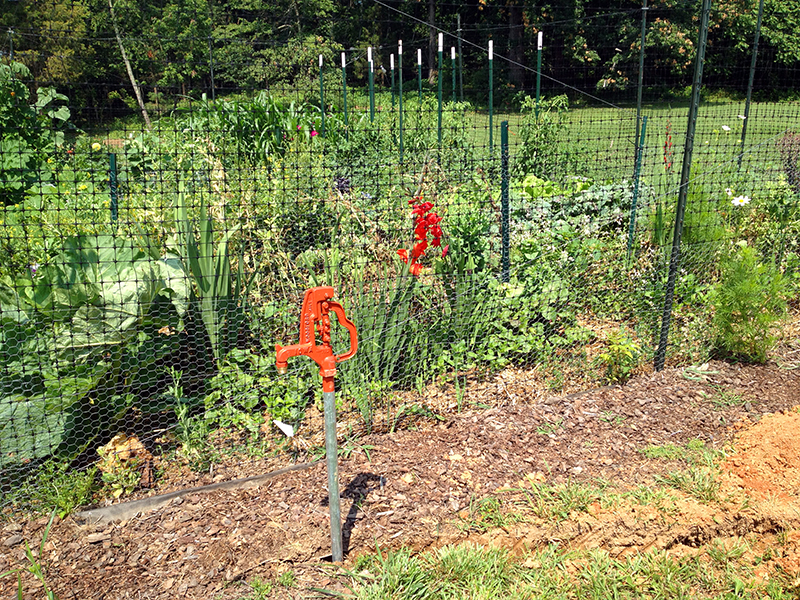
And now I have an awesome water source right where I need it. That I used to water the garden exactly twice this year, as the rain continued and kept things so happy that supplemental water was totally unnecessary. You can see in that photo how far along the garden was on June 25, without any extra water at all.
I know there are bound to be more summer droughts, but I sure was laughing that the year I chose to install the water line is the year I didn’t end up needing it! Oh well. Every little bit of infrastructure I add to this property improves it and takes me a step further along the path of carving a working homestead out of a field.
November 18th, 2013 §
Today dawned in marked contrast to the last few days. In place of cool mist and fog were bright sun and almost 70 degree temperatures. I seized the opportunity to complete the year’s final tasks in the garden that surrounds the house.
I started by robbing my compost pile that’s been in the making for almost a year. It’s a mix of garden waste, grass clippings, soiled chicken house bedding, and kitchen scraps. Instead of engaging in a hot composting process, which requires a more precise mix of nitrogen-rich greens and carbonous browns, plus proper moisture and aeration, I just throw everything in a pile in the woods and let time work its magic. Which it does, yielding a worm-full and deeply nutritious mix that every fall gets spread about the farm.
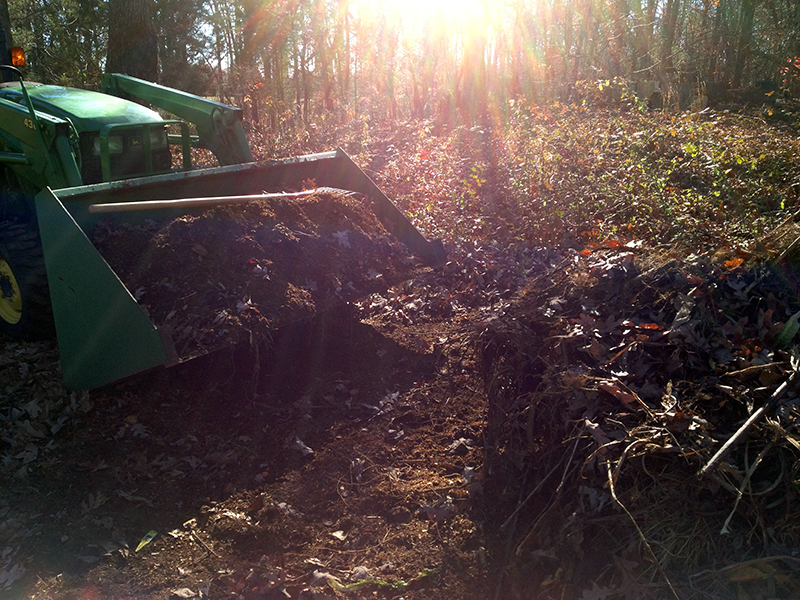
I forked the compost into the big tractor bucket. I prefer using this large bucket when dealing with bulky materials because it can carry much more than the smaller bucket. The downside, though, is that I can’t dig or scoop with this big bucket without damaging the tractor’s arms, so that means lots of hand forking. In many ways this is still necessary, though, as the margins of the pile aren’t well defined and the pile isn’t large enough to efficiently scoop with a small bucket anyway.
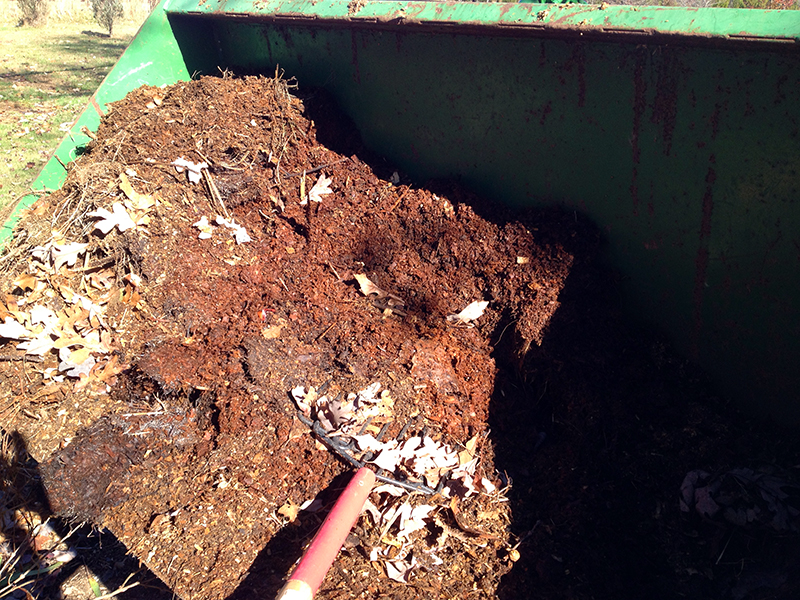
I managed to eek two large buckets of compost out of my pile. It’s not a ton, but I spread it almost an inch thick over all the exposed dirt in the garden and even had enough to pile some extra around heavy feeders, such as the roses.
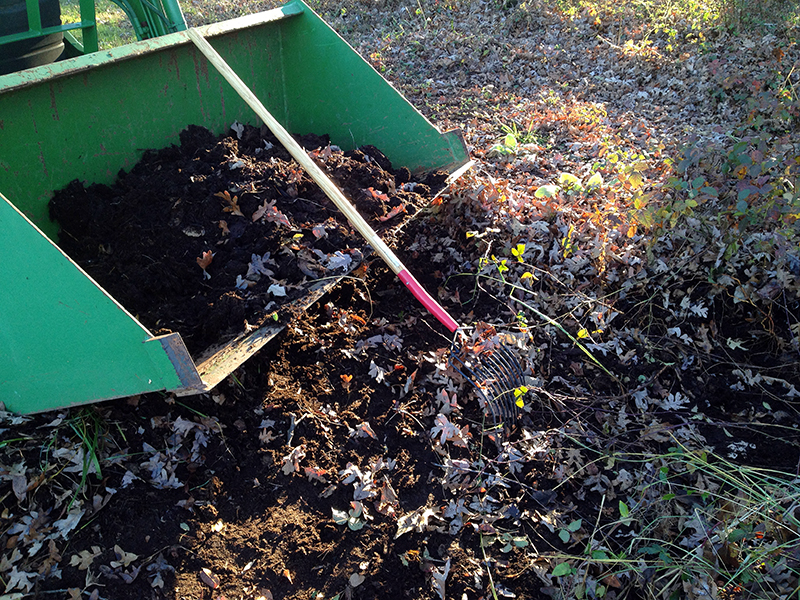
Once the compost was down, I went back for mulch. My target was the remnants of the ten yards that were delivered in early April. They’d been spread about a bit in the field and briars and grass were starting to grow up in the pile.
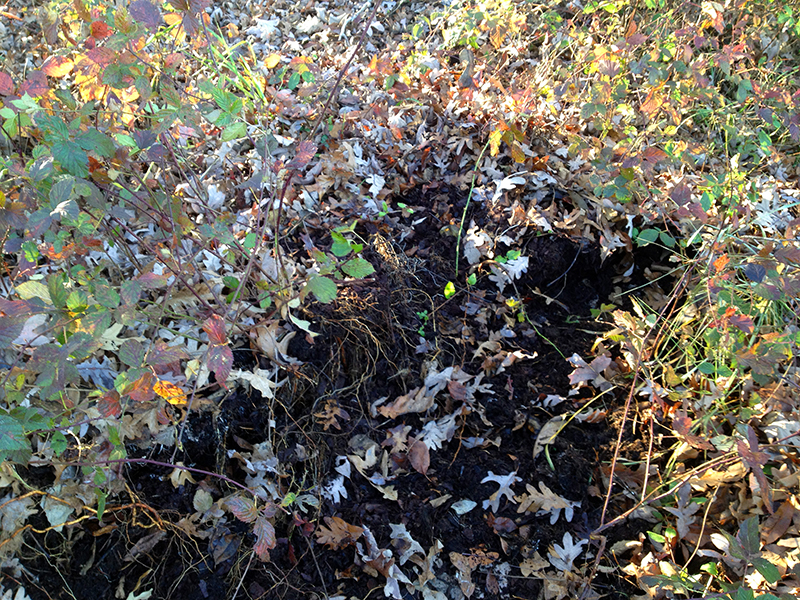
This required lots of hand forking and tedious, prickly picking through, but I managed to get four big bucketfuls out of a rather insubstantial looking pile. Not only did it feel good to reclaim something for which I’d paid good money, but the eight-month rest in the field had decomposed the mulch the absolutely perfect consistency—damp, dark, crumbly and ready to go to work building soil. It makes me realize I should be ordering all my mulch at least half a year in advance of when I want to apply it.
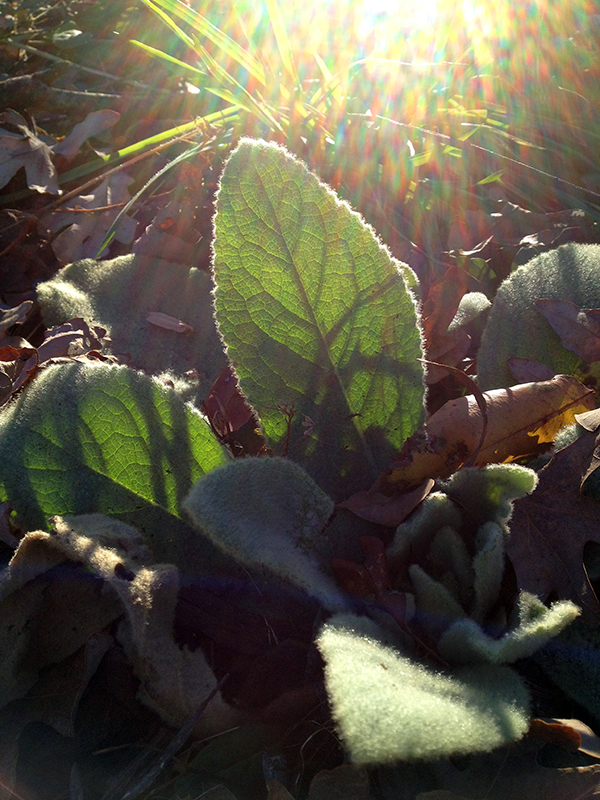
Anyone who’s been reading this blog for a while knows that when it comes to mulch, I prioritize its soil-building properties over any aesthetic contribution it may make to the landscape. The key to building good soil is keeping it mulched with an appropriate material, one that breaks down and adds organic matter to the soil. When you’re working with what I’ve got here—compacted red Virginia clay around a construction site—short of digging out all the native dirt and replacing it the only way to create great soil is through repeated application of amendments such as compost and mulch. Do that for ten or fifteen years and you might get somewhere. I am three years in and my fantasies of dropping a trowel and having it sink blade deep in rich, black soil are a long way off.
But I work at it. And will keep working at it every year as long as I can wield the pitchfork.
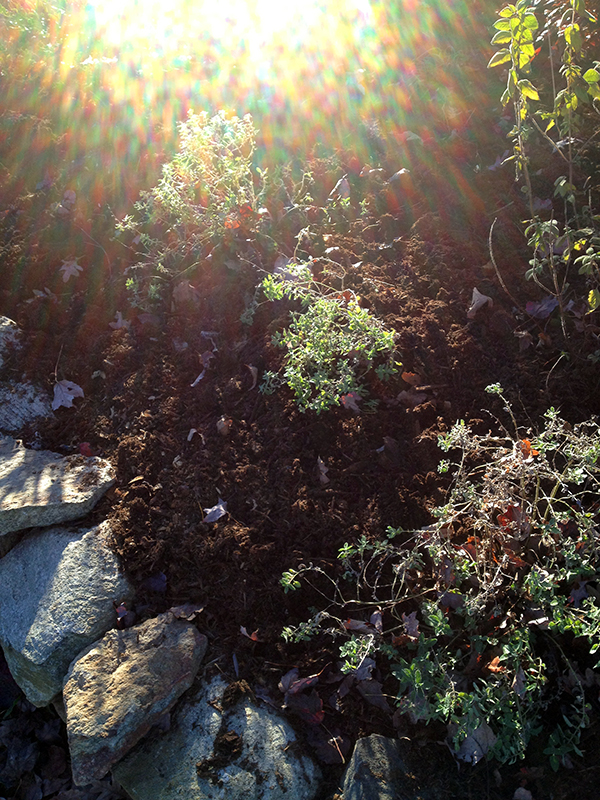
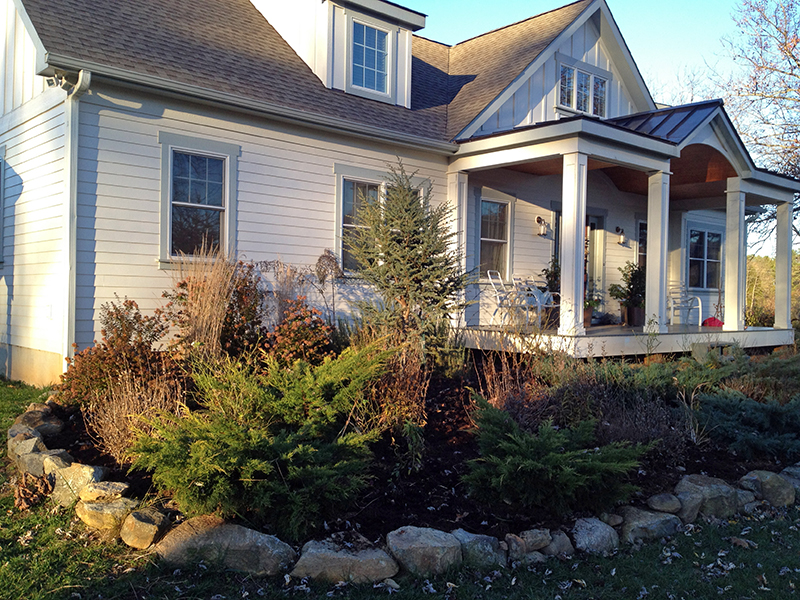
By sundown I could barely move but I was finished spreading compost and mulch, and I felt good about this final gardening act of the year. This is always one of the most physically demanding days of the year, and I am glad to have it behind me. Now I celebrate, and rest easy knowing I have left a nutritious blanket over my garden that will nourish it through this winter and into the spring to come. It’s a good feeling, despite the protest of every nerve and muscle in my bone-tired body. I’m headed for the epsom salts and a scalding bath, and most likely a well-deserved beer.
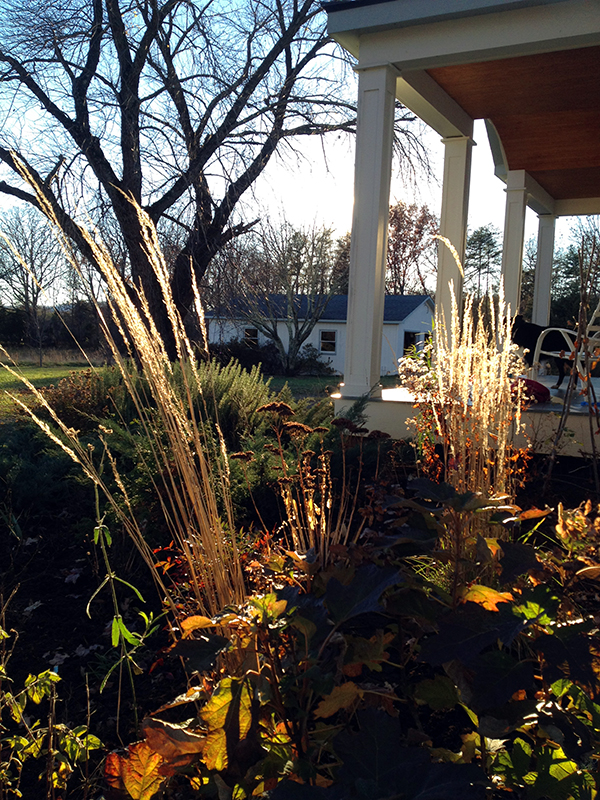
November 4th, 2013 §
Sunday morning dawned just a beautifully as Saturday, though it was cooler and substantially more windy. After lunch I headed outside to keep working at the vegetable garden cleanup. Unfortunately I had overdone it the day before and reactivated an old injury, a muscle spasm in my upper back next to my shoulder blade. In addition to being constantly uncomfortable, it makes turning my head to the right, such as when backing up the car, downright painful. Farming. Let me count the ways it hurts.
Regardless of any physical discomfort, the garden still needed more attention. First I dug out a couple dozen dahlia tubers for winter storage in the garage. I was amazed at the size of most of these tubers—just gigantic. Seeing this, I am suspicious that something caused this year’s dahlias to put their energy into making tubers instead of into flowers. More research on my theory to come.
I moved the dahlias’ labels, which are attached with twist-ties, from the wire support cages directly to the tubers to keep them properly labeled.
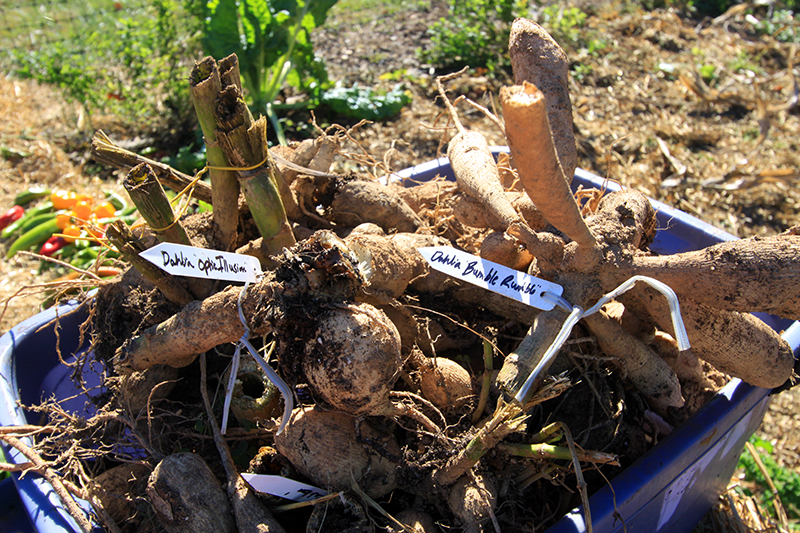
I stacked the custom-made cages and wired their ground pins to them for safekeeping. When I get around to it I will layer the tubers in boxes of peat to keep them from either drying out or rotting during winter. Last year I hung the tubers in mesh bags in the garage and lost some of them to drying out, so I will try a different technique this year.
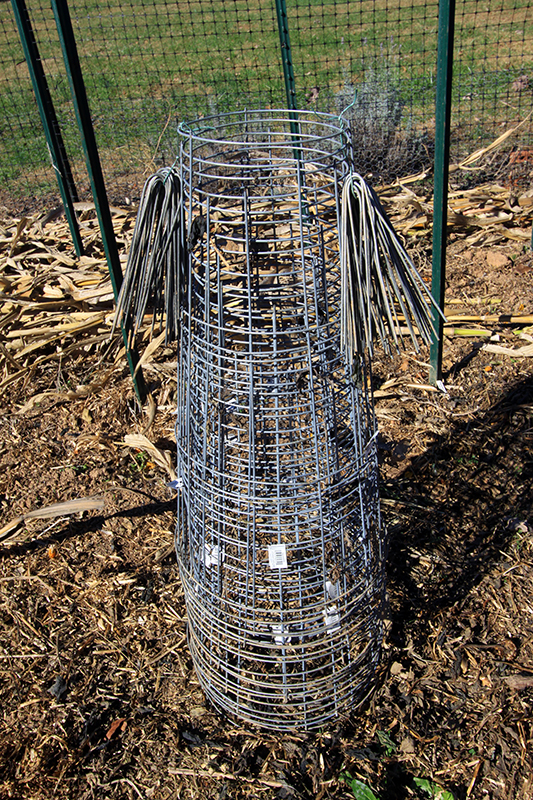
Then I had to figure out what to do with the Glass Gem corn stalks. I tried digging one stalk out, but the root ball that came with it was so massive and full of soil and beneficial worms that I realized I’d be transplanting most of my hard-won, improved garden soil directly into the woods if I chose that route. So I decided to chop each stalk off at the ground and hope that the root balls would just decompose and continue to feed the soil without the major disturbance of digging. We’ll see. I figured that come next spring, anything I’d want to plant in this area can be tucked amongst any stalks or root balls that may be left over.
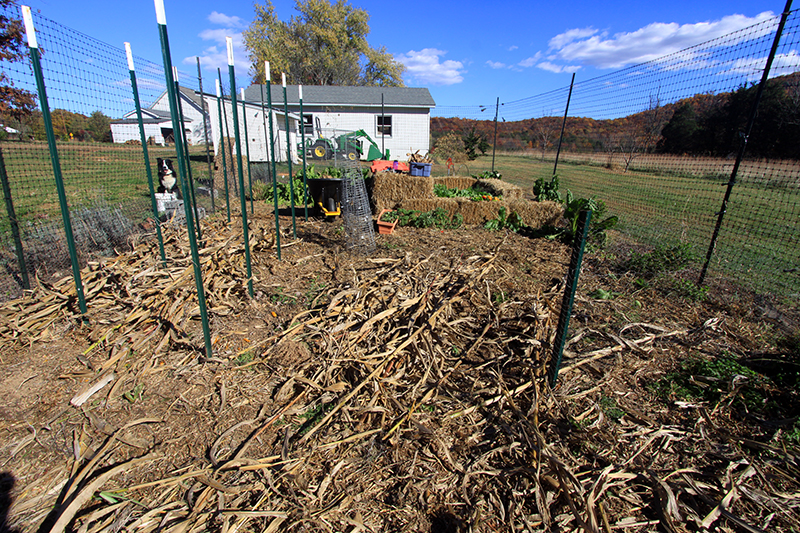
I am undecided about what to do with the stalks. I am heading toward leaving them on the ground over the garden. They will form a nice mulch layer to protect the soil below during winter, and if they’re still around in the spring they’ll be easy to pick up and remove to the compost pile. I plan on putting down a layer of compost then heavily mulching with straw anyway, so these corn stalks perform much the same function and help stretch the straw budget.
I still need to get the tomato stakes out, and then the next step involves shoveling compost into the garden and spreading straw. But as I was not in great compost-shoveling condition with this muscle knot, once I got the dahlias up and the corn down I quit garden cleanup and headed to town for an hour and half of vigorous vinyasa yoga in a warm studio, followed by liberal application of the gym’s hot tub jets to my back muscles.
November 3rd, 2013 §
Anytime after the first freeze of fall I am on the lookout for a few days of nice weather in order to put the garden to bed. This weekend was perfect for the job, with temperatures in the 60s, bright blue skies and sun streaming through the red, orange and yellow trees. Such glorious weather is, I suppose, a small consolation for what is one of my saddest markers of seasonal change. Take a look at this pathetic sight:
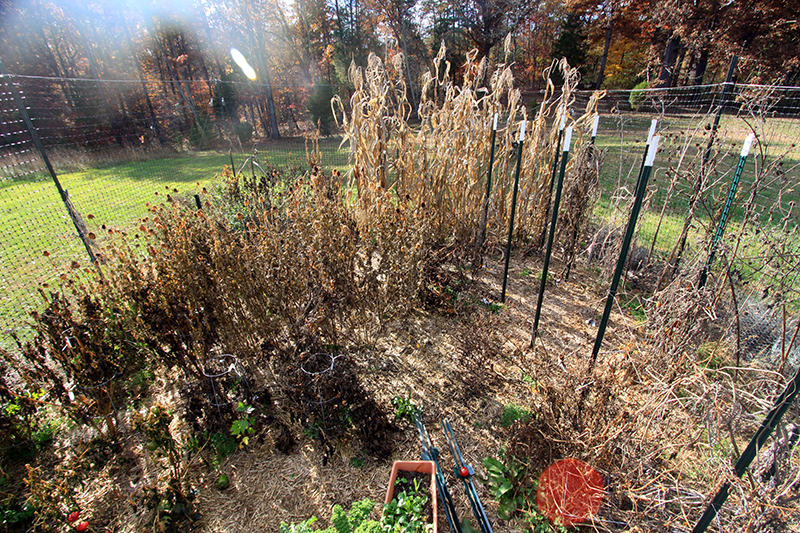
I started with the tomatoes, cutting them down from their stakes.
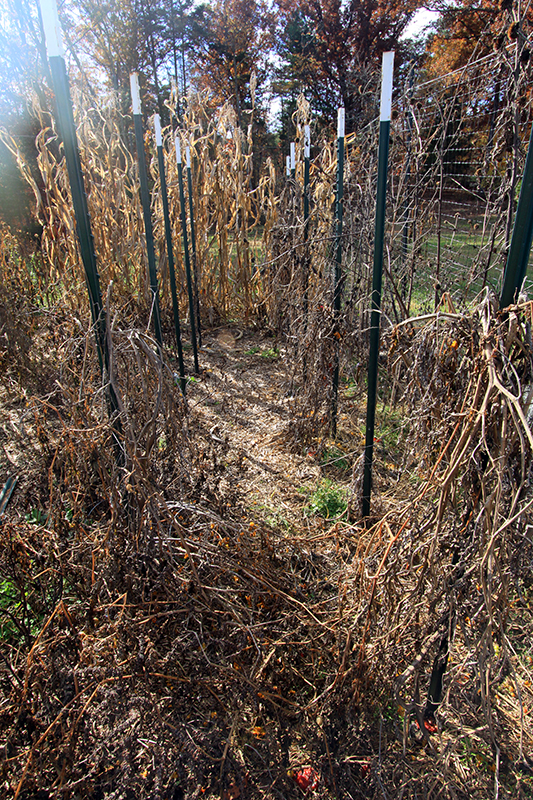
I always use cotton or jute twine to stake my tomatoes so that at the end of the season everything can go right in the compost, which beats having to pick pieces of plastic or wire out of the jumbled vines. I wasn’t too meticulous with picking up the dropped fruit as I plan on running the chickens in here during winter and they will appreciate the treats.
Then I moved on to ripping up the cosmos and zinnias, and as I did I saved seed heads from varieties that did particularly well. I plan to scatter these seeds over some bare spots in hope of starting a wildflower patch.

Then I cut the hyacinth bean vines off of the deer fence. A tedious job, indeed, to avoid cutting the plastic fence. Next year I will sow my hyacinth bean up the sides of the metal chicken run. Finally I pulled the frozen peppers out. I was annoyed at myself to find that there were so many peppers that I hadn’t harvested before it was too late. This is what happens when the first frost happens when the farmer is out of town for a couple of days!

Then I took a break from the vegetable garden to walk through the pastures, cutting out the prickly shrubs that are the first woody plants to initiate reforestation of cleared areas. It took several big tractor bucket loads to get everything to the compost and brush piles in the woods.
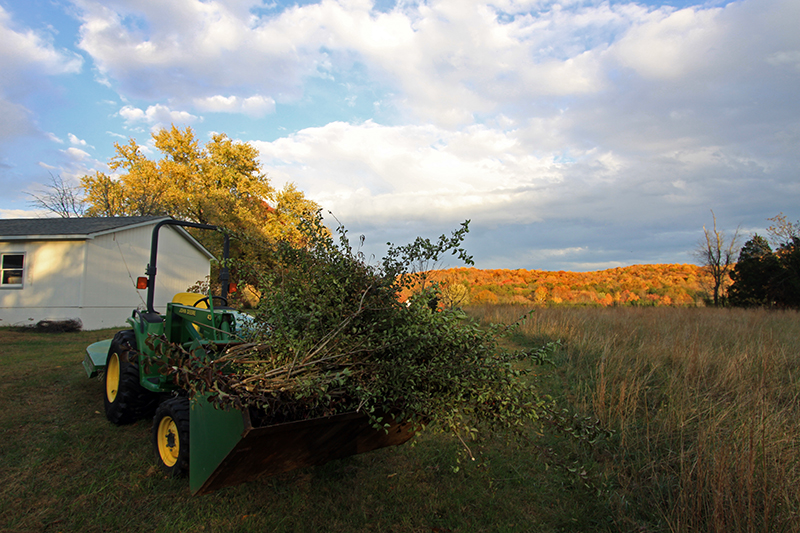
By then the sun was setting and I had been working outside for more than seven hours in a row. So when the chickens headed into roost, I did the same, straight for a hot epsom salt bath. Up next: day two of vegetable garden cleanup.
October 26th, 2013 §
The 2013 growing season came to an end last night with the first freeze of the fall. When I woke up this morning, it was 26 degrees and the ground was covered in thick white frost. 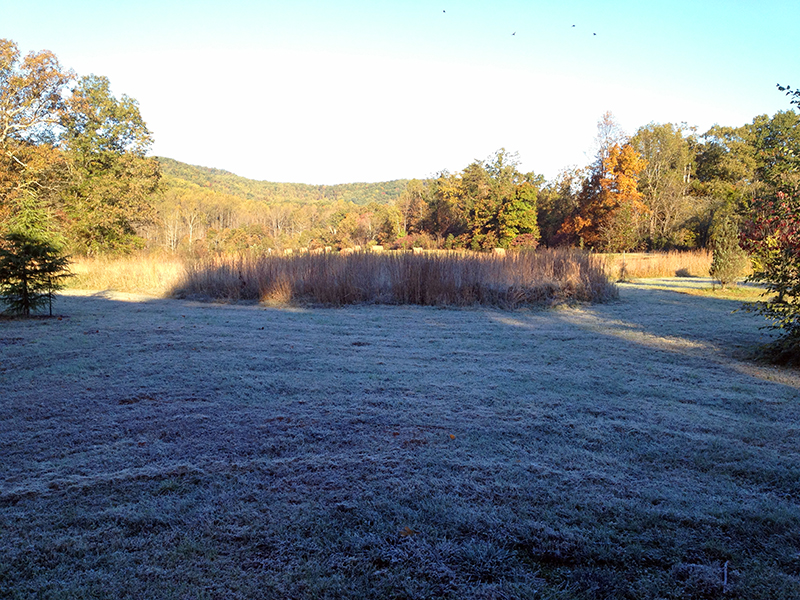
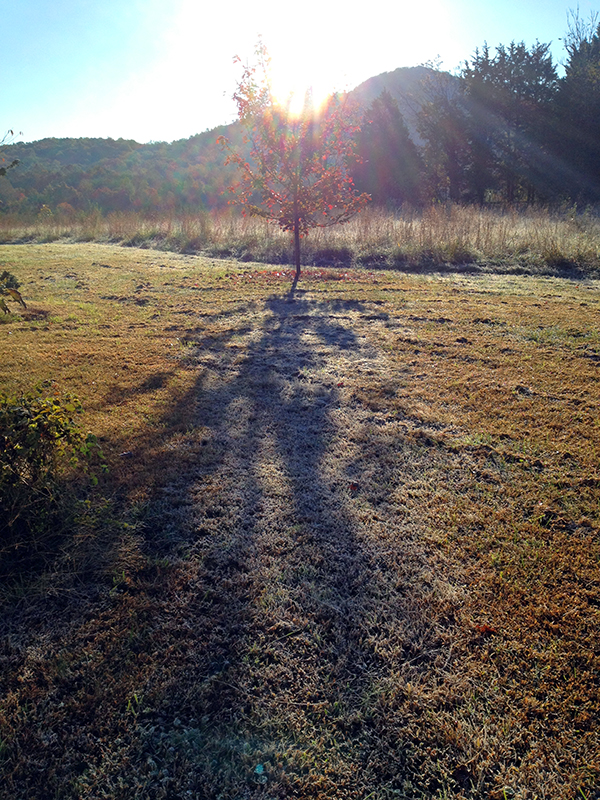
A brisk walk around the farm revealed blackened and sagging flowers, mottled and falling leaves, and the last of the garden peppers reduced to mush inside skin. It is always, for me, the saddest morning of the year. It means no more digging in the dirt and no more daily joy watching my labor become food and flowers. Now all that’s left to do is tear out the dead plants and drag them to the compost pile.
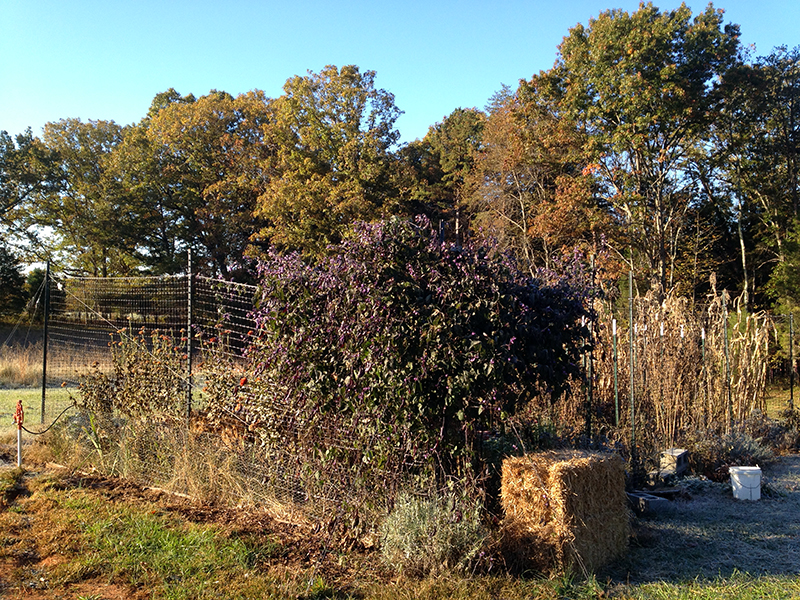
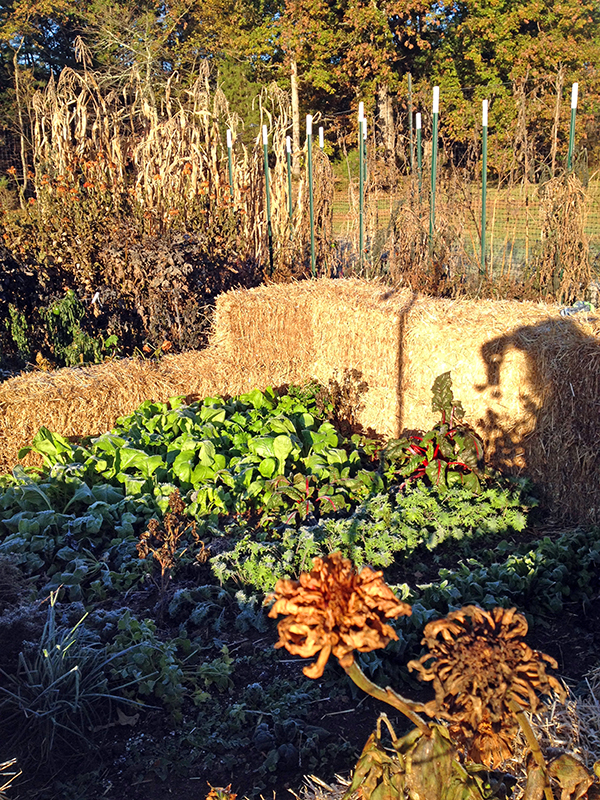
I suppose the only saving grace of this inevitable transition is that it’s now woodstove season. I made my first fire this morning to warm up a 50-degree house. I hadn’t turned my heat on yet this fall, and now it’s up to Jotul to beat back the chill. The stove started right up, drew perfectly, and seems so happy to be back to work and the center of attention. It is the warm white heart of this home.
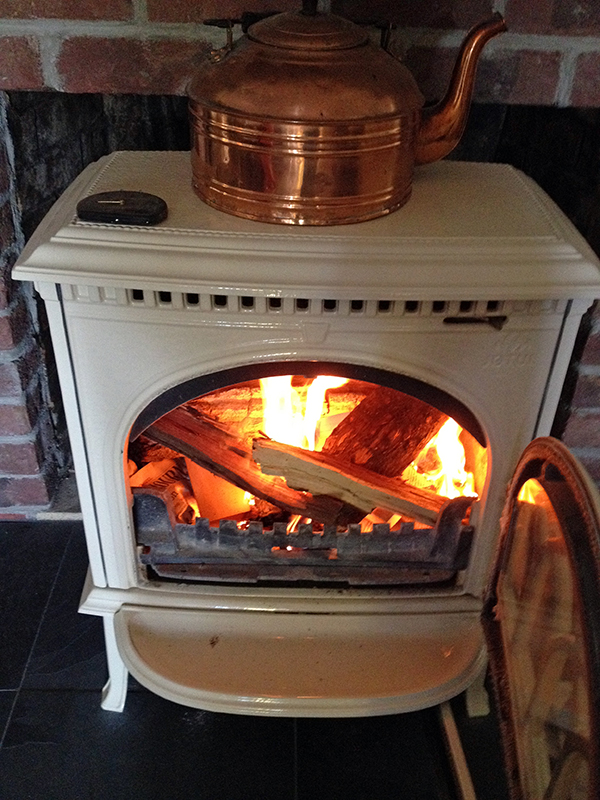
I’ll be back soon with the 2013 garden success and failure post, as well as more info on all sorts of projects that I didn’t get a chance to write about during the busyness of summer. But now it’s time to go put another log on the fire.
July 26th, 2013 §
I had a lightbulb moment today when I realized that there was a way I could use my chickens to control insects in the garden…without sacrificing my plants or produce. I’ve been wanting to let the pest-eating power of my chickens loose in the garden, with hopes that they would attack the harlequin bugs on my kale, and the Mexican bean beetles on my beans. But, of course, when I let the flock in for a trial run they went right to my ripest tomatoes and dug in. They got a few good mouthfuls before I chased them out, and on their way they scratched the heck out of some smaller plants.
I’ve read that some people use bantams (mini chickens) in their gardens to limit the destruction from scratching, and yet other people suggest that Silkie chickens, which have feathered feet, are gentler as they scratch. I’m lacking in the bantam and Silkie departments, but I do have some very mini chickens of my own—the chicks! I knew that with their tiny size they’d be gentler on the plants than the full-grown birds, and being growing babies their appetites just don’t end.
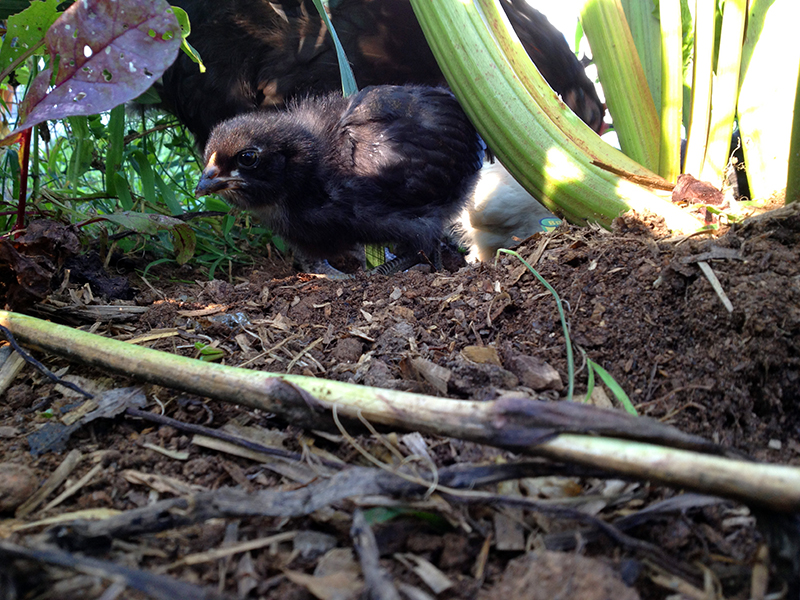
Of course I’d still have to keep the chicks, and their mother, away from the tomatoes. I erected a hasty barricade from a couple of pieces of chicken wire held to the garden posts with zip ties, and then went to fetch my arsenal from the broody coop in the garage.
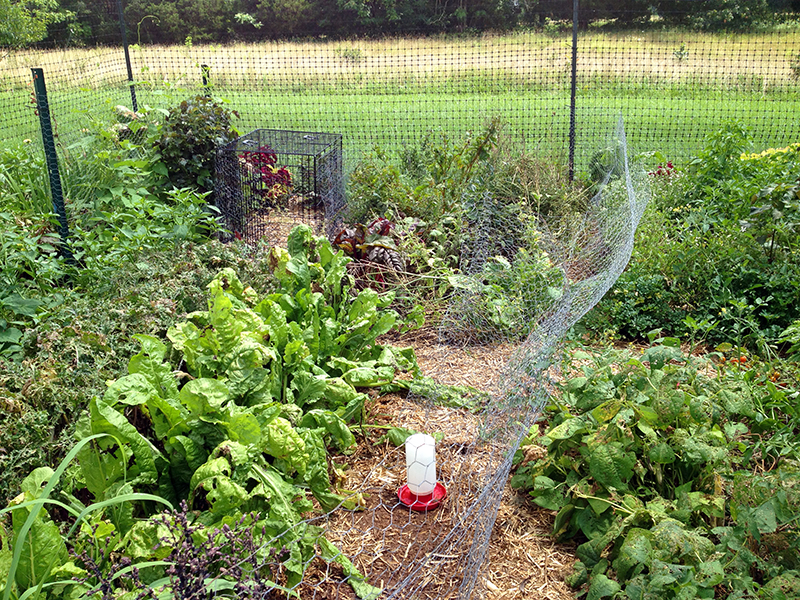
Dahlia’s relief was palpable when I released her into the fenced-off garden section. After a month and a half of living in small coops, and with half a dozen busy babies, I could tell she was dying for some room to stretch her wings. She scratched in the straw, and then lay down to luxuriate in the cool soil with the hot sun on her wings. Two of her chicks immediately imitated her basking behavior, which almost made me fall over from the cuteness.
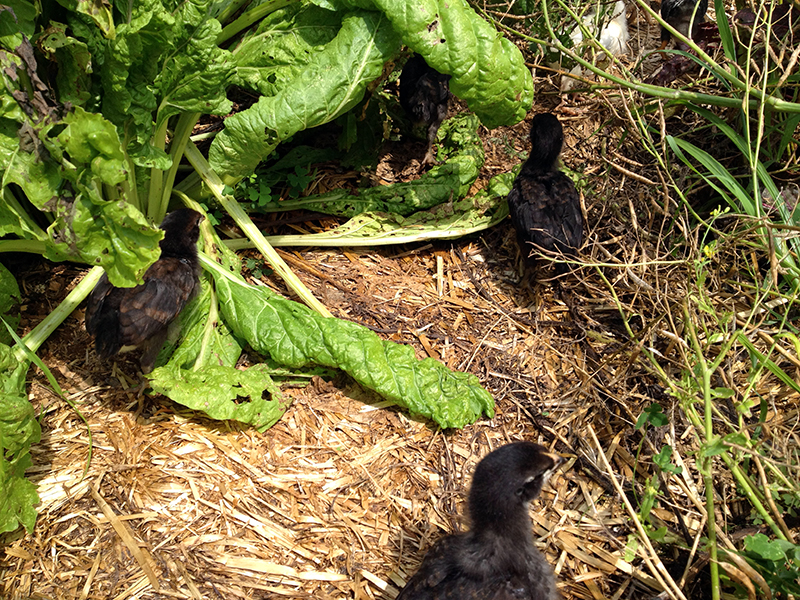
Dahlia and her six chicks spent about eight hours in the garden today. Each time I checked on them they were busy scratching and searching for bugs, sticking close to Mom. They spent a long time under the pest-infested kale, which was great to see. The rest of the flock even came around for introductions, which I hope will help ease things when these babies need to join the adults. After only raising chicks in brooders, it’s a real treat to see natural chicken rearing in action.
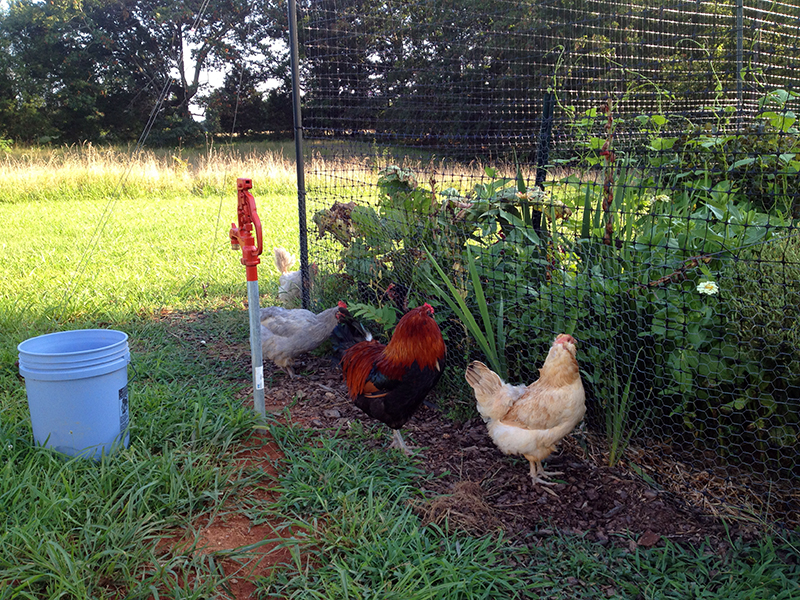
Around sundown it was time to collect the family to return them to the safety of the garage for night. Now this was a hilarous undertaking. I am glad that the only creature around to witness was my dog, and he didn’t judge. I prowled amongst the vegetation, grabbing chicks. I put the chicks in to a five-gallon bucket to carry them back to the garage, but of course they’re now big enough that they easily fly up to the lip of the bucket and jump out. Each time I’d catch and add a chick, one would fly out and go running for its mother. It was a ridiculous chick chase, soundtracked by Dahlia clucking in concern as each baby was lifted airborne.
Eventually I got all the babies corralled and Dahlia tucked under my arm for our journey home. An ungraceful ending notwithstanding, I think it was a good day out of the chicks, and a big help for the garden.
July 6th, 2013 §
We’ve had an unusual, for here, weather pattern during the last few weeks. It’s been raining almost every day, and the air is humid soup. All growing things look great, lush and happy to have all this moisture during a time when we are usually headed into summer drought. I haven’t had to water the garden once in at least a month, and most everything looks very good.
This year I am experimenting with letting some things go to seed. Chard, with its yellow feathery seedheads below, is a biennial. I planted these last year, overwintered them in pots, and now they’re in the garden working on setting seed. It’s a sacrifice to devote square footage to plants that are going to seed, but I am curious to see if I can begin to be less dependent on store-bought seed. I hope that certain things, most especially greens and lettuces, will start self-sowing in the garden, which means less for me to buy, plan and plant each year. And, once plants take control of their own growth cycles, instead of relying on a fallible gardener to tell them when to grow, they usually are much happier and healthier.
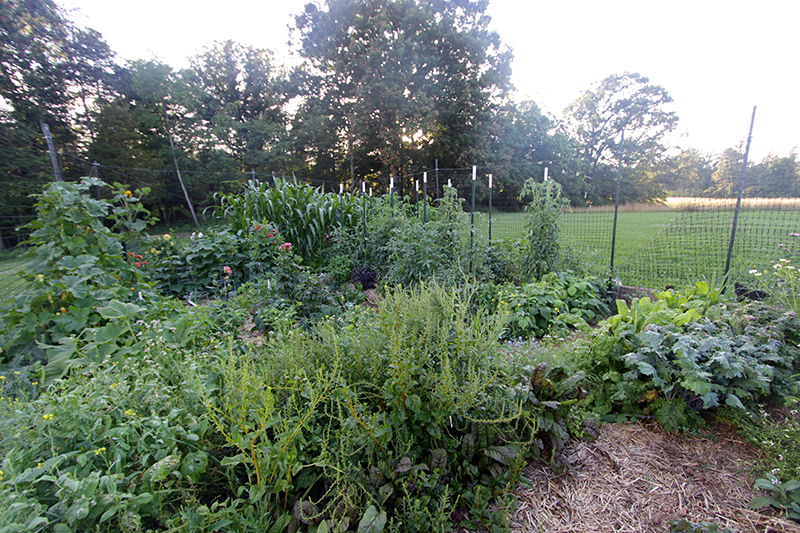
No Fourth of July ripe to tomatoes for me, but the plants are full of green fruit.
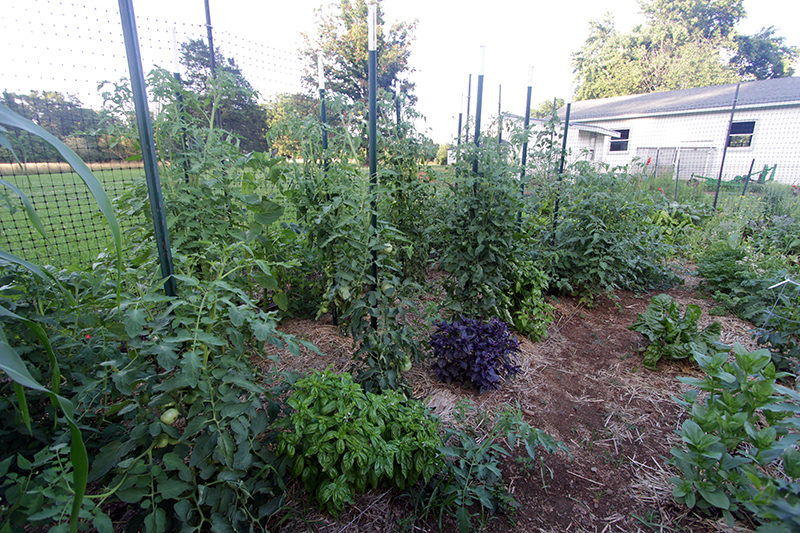
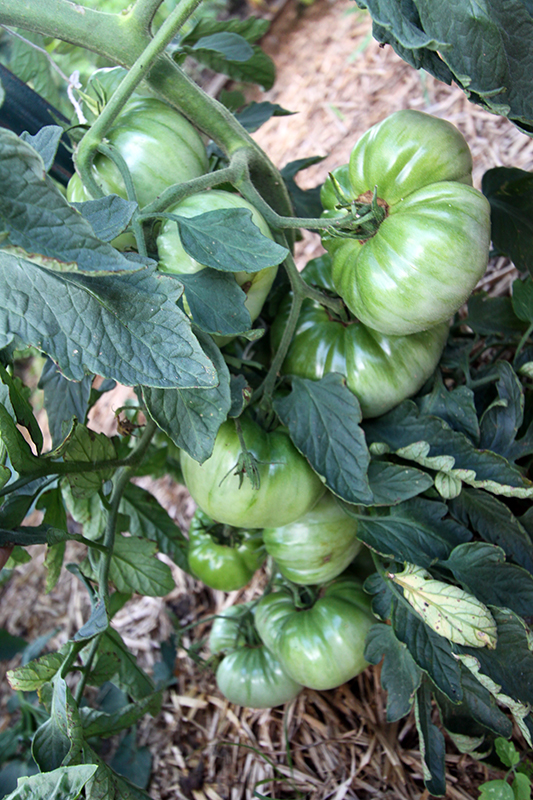
The Sun Sugar cherry tomatoes are just starting to ripen.
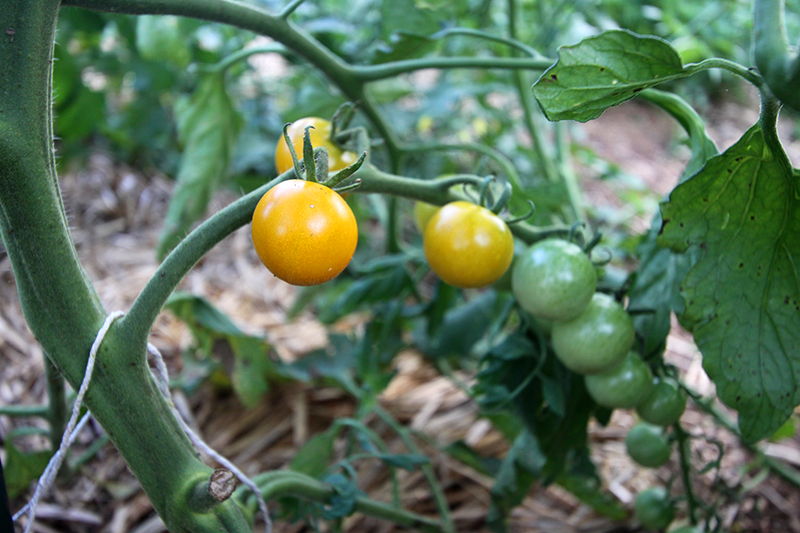
The only downside to all the rain is that it creates good conditions for diseases such a blight and fungus. You can see the beginnings of some blight at the base of this tomato in the yellowing, withered leaves with dark necrotic spots. Nothing to do but remove the affected leaves from the garden to help slow the spread. Some people use chemical sprays to control disease, but they’re an absolute last resort for me and I haven’t used them yet in this garden. Compared with some of my gardening friends, whose tomato plants are already halfway yellow, I am doing okay. I think my planting and mulching practices are paying off.
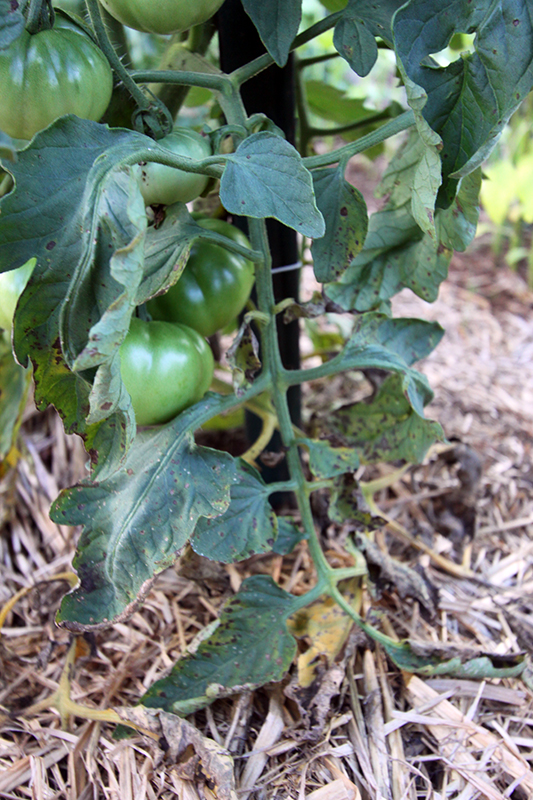
I ripped out the pea vines, which were done for the year, and planted some rattlesnake beans in their place to grow up the trellis. I have never grown these particular beans, but I hear they are pretty great. The big green plant to the right is a volunteer shiso, a wonderfully fragranced Asian culinary herb. I have no idea where the shiso came from—perhaps a neighbor—but it pops up all over my property. When I finally recognized what it was, I let it grow out everywhere as an ornamental.

I think it’s a very beautiful plant that seems to glow from within with a spiritual energy, similar to borage. It’s used in Japanese cuisine for all sorts of things. For example, the red shiso is used to make umeboshi, or pickled plums.
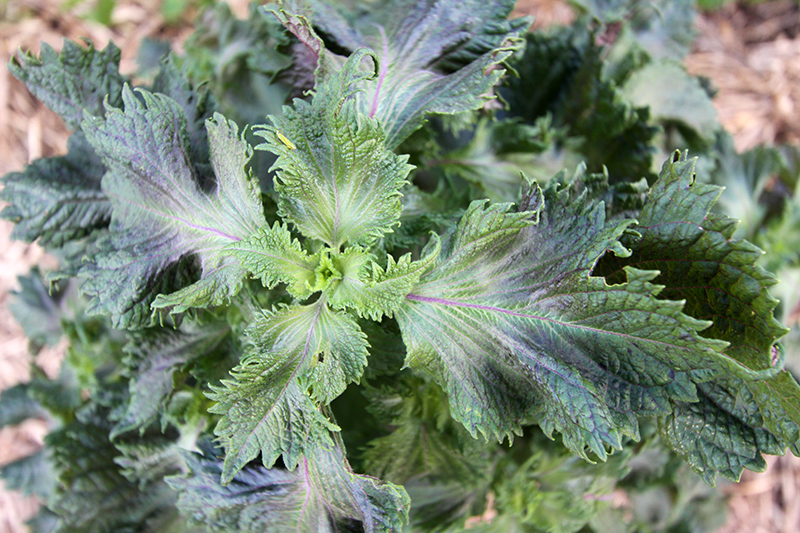
The volunteer vine that I thought was a squash turned out to be a pumpkin! Whoops! I had to cut this pumpkin off before it took down my fence. This plant may not be long for the world anyway as it appears the squash bugs have now discovered it.
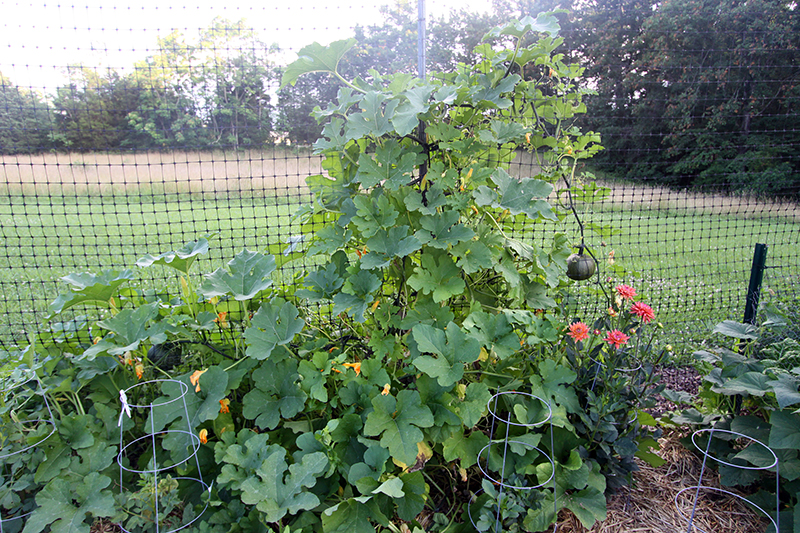
I am drowning in cucumbers. Which is kind of fun as I am on a quest to find the best refrigerator pickle recipe. Any suggestions?
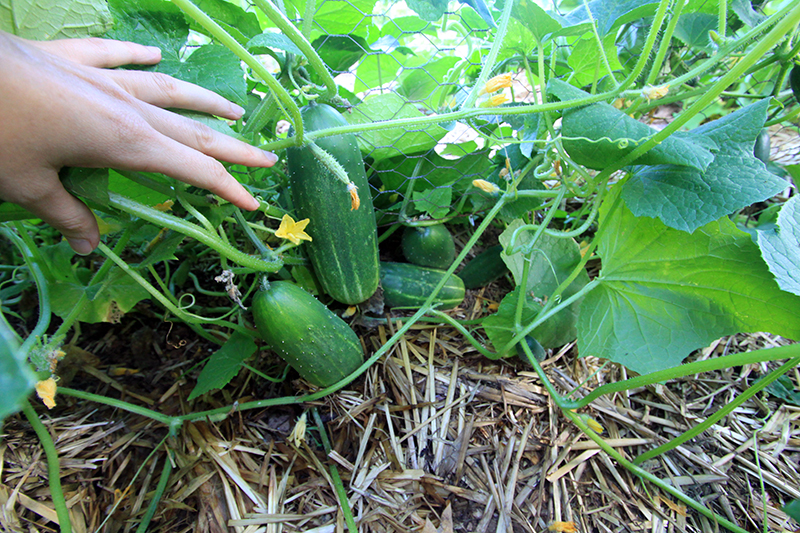
And, because it seems that cucumbers in my garden come on strong before petering out, I started a few more plants up the other former pea trellis. I planted some fun ones I haven’t grown before including an Armenian, lemon, and just another regular old bush cucumber for backup.
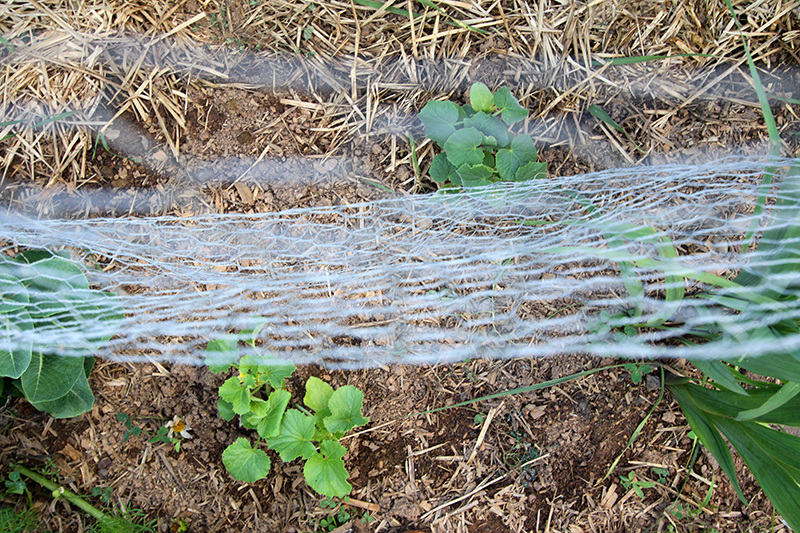
The only sweet peas to bloom from the dozens of started seeds. I think the trick to sweet peas is to plant them in the fall. Pretty pathetic. I will try that this year, as this is one flower I’d like to master.
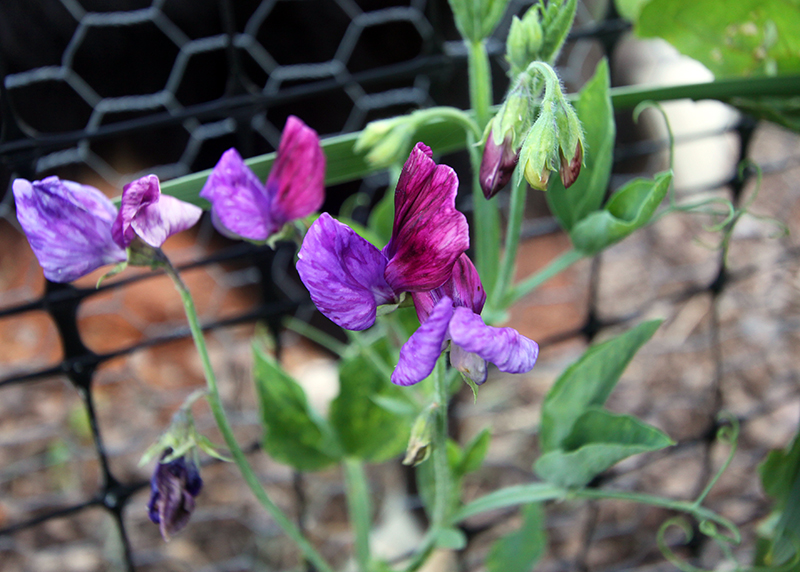
The Japanese beetles have arrived. They aren’t too bad yet, but maybe that’s because everyone I see gets a quick thumbnail through the thorax just before its tossed to a mob of chickens.

Up next, part two of the early July vegetable garden tour…
June 13th, 2013 §
I know I am way overdue with a vegetable garden update. In fact, I haven’t even posted much of anything about the veg garden this whole spring, even though I started working in there in March. The ensuing three months were taken up with gardening, not writing about gardening, so that means we will just jump right into a lush summer garden and skip all the photos of bare spring dirt.
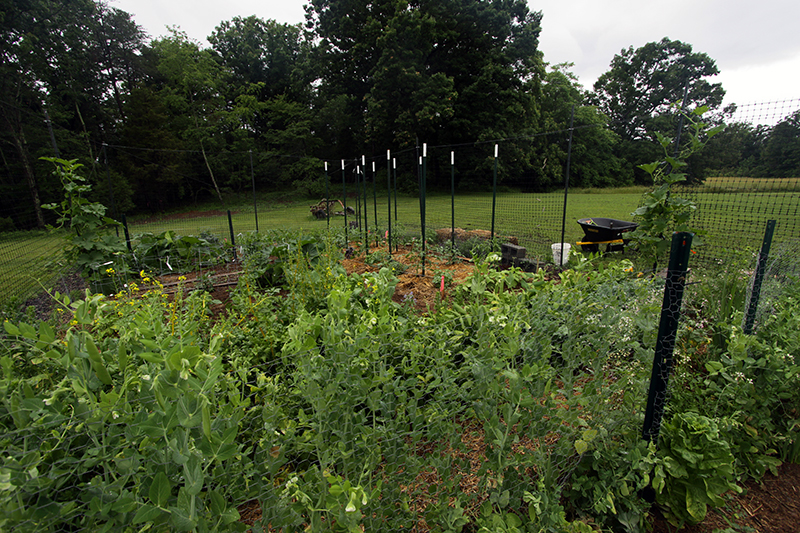
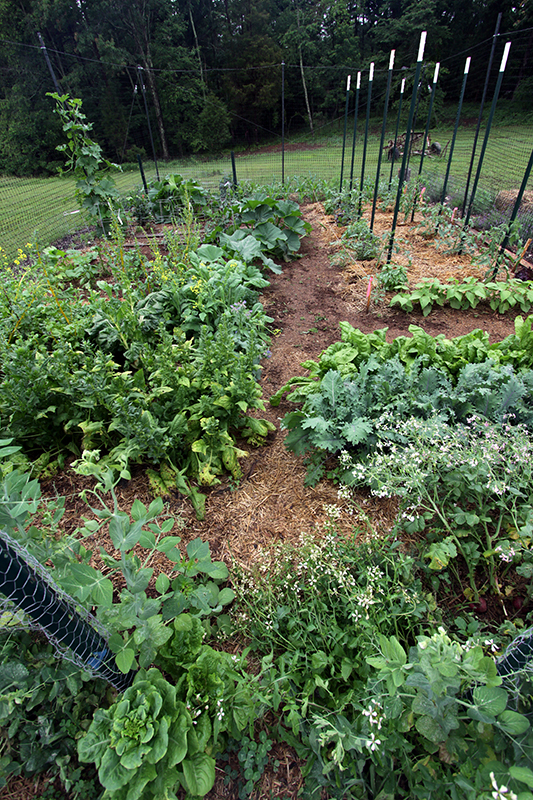
Starting in the foreground of the shot above, I have various lettuces and flowering arugula growing around the sugar snap pea. supports. Then, up the right side of the path are a row of zinnias, the peas, flowering radishes, Red Russian kale, Lucullus Swiss Chard, some dill, and the entry path. Then come some Dragon’s Tongue beans, then my patch of 11 tomatoes underplanted with various basils, a row of mixed wax, green and purple beans, and finally my Glass Gem corn. Up along the fence on the right side are sunflower and cosmos seedlings, and tucked here and there are tomotillos, hyacinth beans, poppies, and a volunteer squash.
Up the left side of the path are, out of view of this photo, sweet peas at the fence, Victoria rhubarb, another row of zinnias, more sweet peast, radishes, then overwintered spinach that’s about to be ripped out and replanted, cilantro, parsley, borage, thyme, a row of red Swiss Chard, overwintered bok choy and yellow chard, blueberries, strawberries, then a row of mustard, followed by rows of arugula and mache. Then some rogue ruffled kale seedlings, and about eight pepper plants. After that we get into the dahlia forest, interplanted with rows of zinnias, followed by the cucumber trellis, a squash, then even more dahlias, nasturtium seedlings, and my mint patch. Whew!
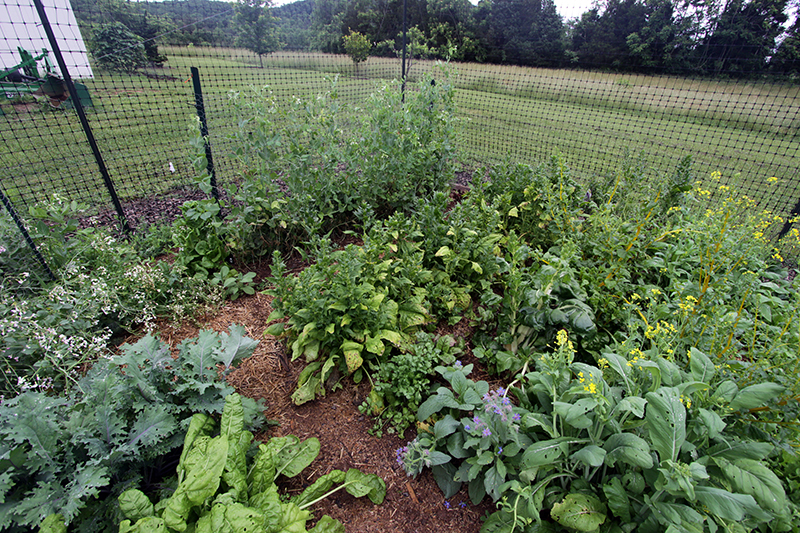
Let’s get closer. Up above are the various greens. The blue flowering plants are borage, and the mustard is blooming yellow. The radishes on the left have beutiful light pink flowers, and they’ve made “radish beans.”

These radish seed pods are actually more delicious, to me, than the radishes. I am glad I let this crop go to seed and discovered a new treat.
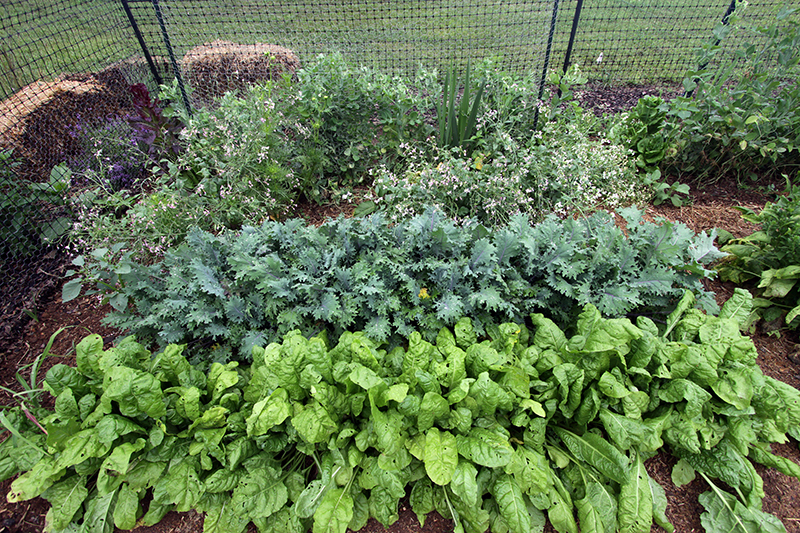
From the top: Peas, radishes, Red Russian Kale, Lucullus Swiss Chard
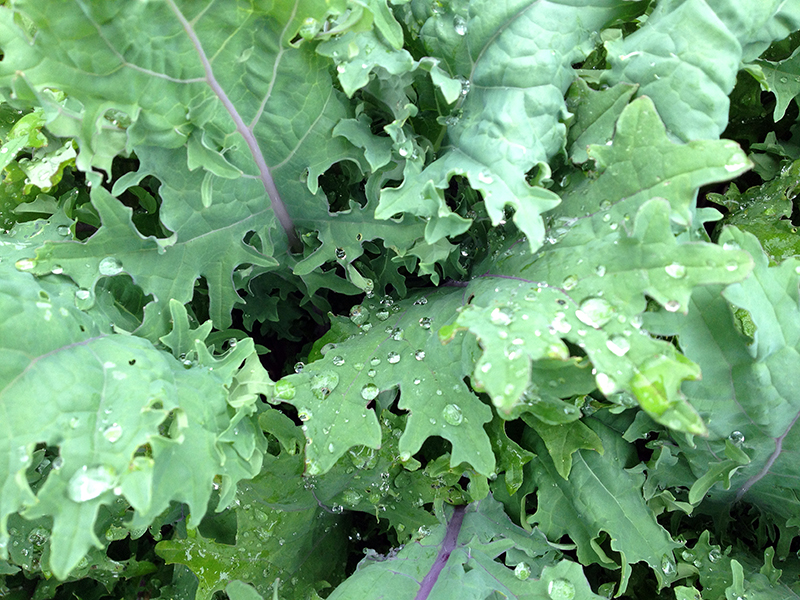
I find Red Russian kale to be one of the most beautiful plants I grow. Every thing about it, from the shape of the leaves to their color, pleases me. Last year my first seeding was preyed on by some sort of stink bug, but this year that bug has held off long enough for me to get a few leaves of my own. I suspect that it will only be a matter of time until the kale falls victim to some other bug, though. Such is the nature of (my) organic garden.
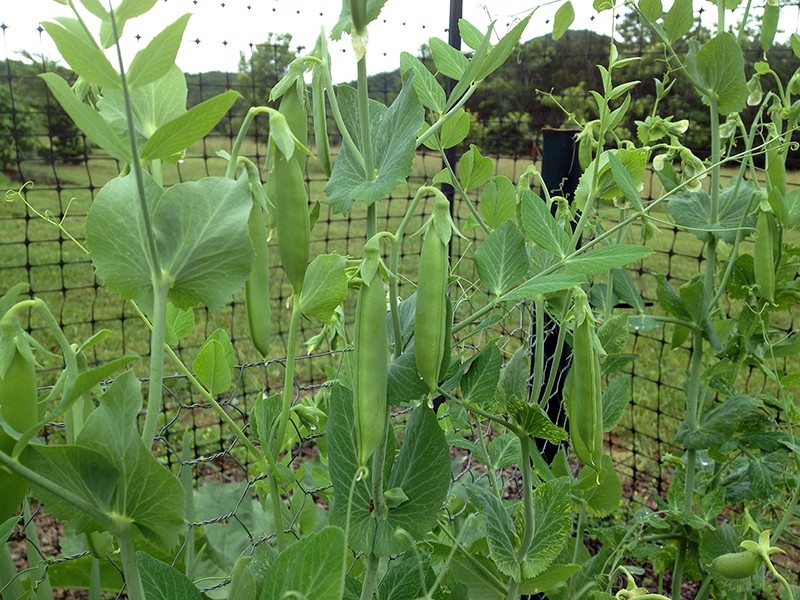
The snow peas are finally coming on. I am puzzled by snowpeas. The seed packets say to sow here in February or March. Well, February just seemed brutal to try to get something to grow, so I waited and sowed in March. It was a month before seedlings emerged. I didn’t get a great germination rate (they were old seeds), so I interplanted with new seedlings in April. These newer plants quickly caught up to the earlier-seeded siblings, just as of of my favorite gardening books said they would. I think this spring’s weather, which has alternated between highs in the mid-90s and being downright chilly, has the peas in a tizzy. I’ll be lucky to get a few delicious handfuls, and that will be it before I rip them out to plant something else. Central VA just doesn’t have the climate for growing these cool-season crops.
Up next: the rest of the garden…
June 7th, 2013 §
Despite how it looks, this story doesn’t have a Disney ending. Stop reading now if topics such as the natural order, predation, working farm dogs, and death are ones you’d rather not read about right now.

For the last week or so the garden around my house has been plagued by a nocturnal visitor. Every young and vulnerable plant fell victim, including new seedlings of rare, mail-ordered zinnias, the newest shoots of dozens of star gladiolus that were just emerging, small bedding coleus, and young red chard transplants that I’d been watering three times a day to get them to take—basically everything I’d lined up to provide summer interest in my garden. As any gardener knows, there is nothing more disheartening than to spend money and time fussing over young plants just to come out each morning find them eaten to the nub.

Because of the pattern of damage, I suspected a rabbit. My suspicion grew Wednesday morning when Tucker went nuts in the front garden, trying to climb inside some of the larger shrubs. I knew he was in pursuit of something, but I feared that in his frenzy I’d lose even more plants. So I called him off and kept him inside.
That night, however, he was outside with me and spent hours working something near the corner of the well house. Around sunset I went outside and found the scene above. There was no going back—the rabbit had already sustained significant damage.
I like this photo below because it reminds me of all those classic paintings of working dogs with their quarry: the labs with their ducks, spaniels with grouse and pheasant, hounds with deer and boar and bear, and terriers with ground-dwelling varmints.
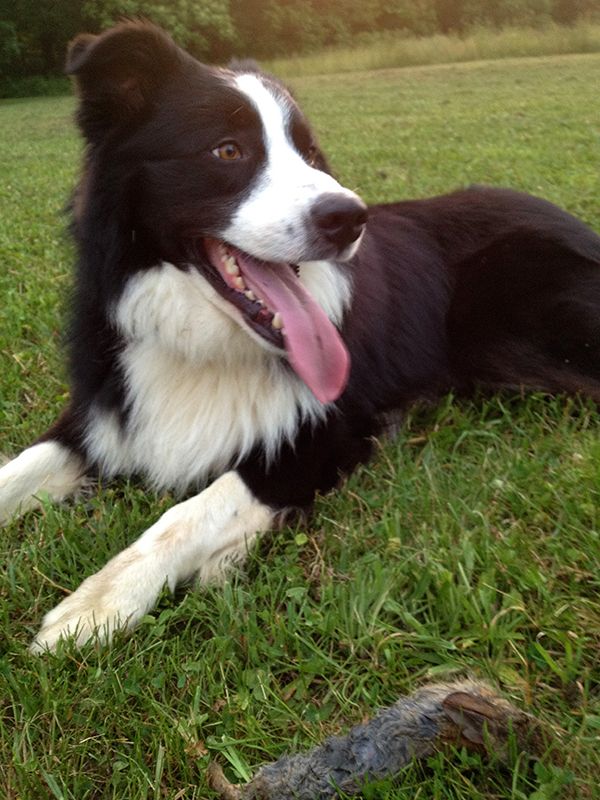
Because I think it is important to reward Tucker for this hunting behavior, which is exactly the kind I want him to exhibit. So I praised him and left him with his kill. And he was oh, so proud. When I went to collect him for bed, at almost 10:00 p.m., he was crunching the last of the bones.

Yes, the rabbit was adorable and I think they are lovely creatures. I enjoy seeing them in the fields ands try my best to not hit them when they dart in front of my car. But this rabbit picked the wrong salad bar, and I am proud that I have an English Shepherd that is pulling his weight around the farm as a working dog as well as a pampered pet. Like all the happiest dogs, he has a job and it is a joy to see him able to fulfill his nature in such a helpful way.








